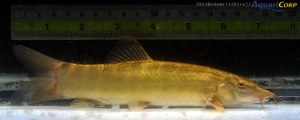Syncrossus beauforti
Summary
< Back to "Telling Tigers Apart"

Scientific name:
Syncrossus beauforti(Smith, 1931)
Common name: Beaufort's Loach, Tiger Botia, Chameleon Loach.
Synonyms: Botia beauforti
Distribution: Cambodia, Thailand, Malaysia.
Sexual Dimorphism: Mature females probably have a rounder abdomen.
Maximum size: 7 inches (18cm)
Similar to: Syncrossus berdmorei.
Care: This species lives in swift streams and large rivers, over rock and gravel substrates. The substrate must ideally be fine sand to allow digging without damage to the barbels. Provide plenty of hiding places in the aquarium amongst bogwood, caves, and sturdy plants. Subdued lighting is required. Though smaller than other Tiger Loaches, S. beauforti still requires plenty of space so that aggression is reduced amongst the group. No less than 5 should be kept together.
Feeding: Will accept most brands of dry sinking catfish pellets, but should be offered a variety of frozen foods to supplement the diet - mosquito larvae and brineshrimp are usually taken with much enthusiasm. Larger specimens will take mysis shrimp, krill and chopped prawns.
Water parameters: pH: 7.0 or below. Hardness: Soft and slightly acidic is best. Max dH: <12 degrees.
Temperature: 77ºF to 86ºF (25-30°C)
Breeding: Not known to have been bred in aquaria.
Notes
The smallest, and least spectacular member of the Tiger Botia group, particularly in adulthood, S. beauforti is no less aggressive than its larger brethren. It is unsuitable for community aquariums, and must be kept with robust, large and fast-swimming fish, for example, some of the more gregarious medium-large sized members of the barb or danio families. Can be kept with other aggressive loach species such as Syncrossus helodes, Syncrossus berdmorei, Yasuhikotakia morleti etc. Clean, well-aerated water is a must.
Sometimes confused with S. berdmorei when young. They can be easily told apart in adults due to the disparate size, and S. beauforti becomes a rather plain fish. Adult S. berdmorei can reach 10 inches. A good indicator in juveniles is the direction of the  stripes anterior to the dorsal fin. In S. beauforti, the stripes are orientated so that they start at the dorsal surface with the bottom of the stripes finishing further towards the rear of the fish. Posterior to the dorsal, the stripes are only slightly more vertical. In S. berdmorei, the stripes posterior of the dorsal are vertical. S. berdomrei has a series of mixed size, dark oval spots and dashes, aligned horizontally in rows along the dorsal half of the body, and two prominent black stripes that run from the nose and over above the eyes, breaking up into two rows of dashes as they go towards the dorsal origin. Two finer black lines connect the dark rostral barbels and the eyes. S. beauforti shares a similar pattern, but the markings are much smaller, and this species lacks the prominent black stripes above the eyes.
stripes anterior to the dorsal fin. In S. beauforti, the stripes are orientated so that they start at the dorsal surface with the bottom of the stripes finishing further towards the rear of the fish. Posterior to the dorsal, the stripes are only slightly more vertical. In S. berdmorei, the stripes posterior of the dorsal are vertical. S. berdomrei has a series of mixed size, dark oval spots and dashes, aligned horizontally in rows along the dorsal half of the body, and two prominent black stripes that run from the nose and over above the eyes, breaking up into two rows of dashes as they go towards the dorsal origin. Two finer black lines connect the dark rostral barbels and the eyes. S. beauforti shares a similar pattern, but the markings are much smaller, and this species lacks the prominent black stripes above the eyes.
S. berdmorei has a fairly slender caudal peduncle area. In S. beauforti, the area is only slightly less deep than the body.
Adult S. beauforti lose their vertical stripes and become a somewhat bland brown fish with a few of the dark spots remaining.
For more information see: Telling Tigers Apart - The Syncrossus Group of Loaches
Photo Gallery
Click to view all images of this species! |
Document Actions


